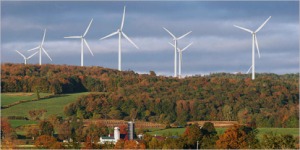By Peter Bardaglio, Senior Fellow, Second Nature
Welcome to the September 2011 issue of the TCCPI Newsletter, a monthly update from the Tompkins County Climate Protection Initiative (TCCPI).

Welcoming the Winds of Change: Enfield Energy
In the works for several years, the Enfield Energy Black Oak Wind Farm project has gained new momentum in recent weeks. The company held a meeting at the Tompkins County Chamber of Commerce earlier this month with potential board members. At the meeting, Enfield Energy’s co-owner and project manager, Marguerite Wells, reported that construction on the 35-50 MW Black Oak Wind Farm site is slated to begin in late 2012 or early 2013.
Adopting a financing model developed by the South Dakota Wind Partners(SDWP) project, Enfield Energy plans on making an in-state public offering of the company as a way to raise the necessary capital. Consultants from the South Dakota firm Val-Add Service, which served as the project coordinators for SDWP, explained how this approach works and why they thought it would be a good fit for Enfield Energy, given its commitment to community ownership.

Maple Ridge Wind Farm in Lewis County, NY.
Next steps for the Black Oak Wind Farm include securing financing for the $105-120 million project, developing siting details for up to twenty turbines, and choosing proper turbine designs. Power purchase agreements are currently being discussed with several potential parties. To date, Hess Corporation, AES, Shell, and Ithaca College have expressed verbal interest in purchasing power.
Enfield Energy expects to complete its environmental impact statement next month, and is working on its second of three interconnection studies with the New York Independent System Operator (NYISO).Two crane-ready access roads have been constructed, with a total of approximately 1.5 miles in length, which allow entry to the two main wooded areas for turbines.
In 2009 the Town of Enfield passed a wind energy ordinance, laying out the parameters within which Enfield Energy could work and regulating operational aspects such as noise levels, insurance, property setbacks, and safety. The company began meteorological monitoring at the planned wind farm site in 2006 and determined after collecting several years of data that the site provided enough wind to make the project financially viable.
A key advantage of the site is that a high-voltage transmission line crosses through it, making it relatively easy to tie into the existing grid. Often constructed in remote areas, wind farms can incur major costs connecting to the grid. The combination of strong winds and existing infrastructure makes clear that the site has great potential to generate cost effective clean energy.
According to Wells, Enfield Energy may be the first female-owned renewable energy enterprise in the country. She notes that the company will employ local contractors and provide workforce training. In addition, revenues generated by the project will help improve local services and lessen the residents’ tax burden. The Black Oak Wind Farm will also open an educational center at the site to educate the public on the possibilities and science of renewable energy, including wind, solar, and biofuels.
Hannah Foster
TCCPI Intern
Climate Protection Initiatives in Rochester and Syracuse
Tompkins County is only one of many communities in upstate New York taking action on climate change. Last month we focused on Albany and Binghamton; this month we look at what Rochester and Syracuse are doing to meet this increasingly difficult challenge. As with Albany and Binghamton, Rochester and Syracuse demonstrate the kind of local leadership that we need across the country in the absence of federal action on climate change.
Rochester

Rochester has made significant progress in recent years on the climate protection front.
Rochester is a signatory to theU.S. Conference of Mayors’ Climate Protection Agreementand a member of Climate Communities, the Climate Registry, ICLEI – Local Governments for Sustainability, and the NY Climate Smart Communities Program. The mayor has established an interdepartmental Green Teamand in 2009 signed a Climate and Environment Protection Resolution, which calls for a greenhouse gas inventory and local climate action plan. City officials expect to begin their work on the climate action plan by the end of the summer, and a number of initiativesare well under way, including greening the city’s fleet and reducing the city government’s overall energy consumption with HVAC upgrades, efficient lighting systems, U.S. Green Building (LEED) standards, and employee education.
Syracuse
Syracuse is also a member of ICLEI and the NY Climate Smart Communities Program. A signatory to the Mayors’ Climate Protection Agreement, Syracuse was the first city in New York to join the Climate Registry. The city achieved its original goal of reducing energy use 20 percent by 2006, and in 2007 Syracuse became one of the first cities in the state to adopt green building standards for all new construction and major renovations of city-owned municipal buildings. Syracuse has has taken many positive steps towards sustainability and is in the process of developing its climate action plan. Syracuse University, having signed the ACUPCC, has released its climate action plan, as has SUNY-ESF, which seeks to achieve carbon neutrality by 2015.
One last thing:
Governor Cuomo’s regional economic development initiative has created an outstanding opportunity for Tompkins County and the other seven counties in the Southern Tier to think strategically about investing in energy efficiency and renewable energy.
In particular, the implementation of large-scale commercial energy efficiency and renewable energy projects throughout the Southern Tier could have a significant positive impact on our economic future. These projects would focus primarily on airports, school systems, college and university campuses, hospitals, and local government buildings, but could also include commercial and industrial buildings.
Each of the ten regional councils, including the Southern Tier group, has until November 14 to submit proposals for a share of a $1 billion fund that the governor has established on behalf of a coordinated economic development strategy. The funding has been put together from multiple agencies, in the form of grants and tax incentives.
The ability to leverage a small portion of this public funding to develop potential sites for energy upgrades, carry out the feasibility studies, and issue the RFPs will make it possible to attract the necessary private capital. By aggregating these projects and coordinating the effort, an attractive investment portfolio will be established, hundreds of jobs created, administrative costs substantially reduced, and significant energy savings realized.
The key, then, is scale. Such a sweeping initiative will require a collaborative platform similar to TCCPI for deploying clean energy technologies across government, commercial, industrial, and educational organizations for maximum impact on economic growth and environmental health.
In short, TCCPI provides a model for multisector collaboration that could mean a brighter future for the region’s citizens, demonstrating that job creation, energy security, and responsible stewardship of the environment are not mutually exclusive.
Best wishes for a productive and engaged fall!
Next TCCPI Meeting:
Friday, September 30, 2011
9 to 11 am
Borg Warner Room
Tompkins County Public Library
101 East Green Street
Ithaca, NY 14850

Add new comment